Millions of us wake up each day with muscle, joint...
Read More
Menu
Close
Lorem ipsum dolor sit amet, consectetuer adipiscing elit, sed diamnonummy nibh euismod tincidunt ut laoreet dolore magna aliquamerat volutpat. Ut wisi enim ad minim veniam, quis nostrud exercitation ullamcorper suscipit lobortis nisl ut aliquip ex ea commodoconsequat.
Millions of us wake up each day with muscle, joint...
Read MoreIf you’re an “injury prone” athlete, then you know full...
Read MoreCarolyn Vanzlow has an incredible story to tell. Her journey...
Read MoreGOLF IS HARD ENOUGH, WITHOUT IT HURTING YOU TOO Is...
Read MoreYour neck hurts occasionally. Every couple of months you get...
Read MoreDoes your back hurt when you sit too long? Most...
Read MoreThey are everywhere, aren’t they? If you search online for...
Read MoreFixing Your Back Pain We all know back pain is...
Read MoreNo, the straps don’t work, period. But, there is a...
Read MoreWow, there is so much to blame moms for; emotional...
Read More“Prior to participating in postural therapy, users responded that they...
Read More“Users also reported a positive impact on their work and...
Read More“The overall factor-of-two superiority of PTX over Control Group was...
Read More“Symptoms evaluated: Headaches, Neck, Shoulder, Elbow, Wrist & Hand, Upper...
Read More“The PTX group experienced highly significant improvements (reductions) in their...
Read More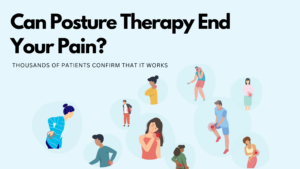
Millions of us wake up each day with muscle, joint or back pain. From loosing your job to giving up your favorite activities, chronic pain can put a real damper on your quality of life. Sadly, traditional treatments, medications, and surgeries have not yet solved the pain epidemic afflicting so many. Fortunately, there is a new player in the pain-relief game. Posture Therapy is a promising new alternative for its low-risk, simple methodology that has been proven effective for a wide range of pain conditions. Posture Therapy really isn’t all that new. It has been around for over 40 years. It’s receiving new attention however, as thousands of testimonials(1) from patients of trained Posture Therapists and a recent clinical study provide evidence that Posture Therapy is worth a try. The Journal of the American Medical Association published a randomized clinical trial performed from 2017 to 2020 which determined Posture Therapy is “as good or better at treating spine pain than usual medical care.”(2) There’s even a book written about patients whose lives were changed by posture therapy. Many are patients who had not found relief anywhere else.(3) Not only does Posture Therapy provide better pain relief for all kinds of muscle and joint conditions, it is also risk-free compared to prescription meds and invasive surgeries. What is Posture Therapy? Posture therapy is the correction of posture to relieve muscle and joint pain. Each patient’s posture is analyzed in comparison to the ideal human posture. Special exercises which are specially sequenced for optimal results are prescribed to restore proper joint angles and muscle strength. A few key principles make posture therapy different from many other exercise or pain relief therapies that may have failed you. Posture Therapy Differences: Whole-body Treatment Focus Specific, Unique-to-each-patient Therapy Plans Simple, Easy To Perform Movements Focus on Posture Improvement 1. Whole Body Focus Posture Therapy is one of the only pain relief therapies to assess and correct imbalances from head to toe, no matter where your symptoms present themselves. Pain and symptoms in one area are often caused by something that is happening in another area. With a whole-body therapy plan, the root cause of the pain will be identified and addressed more quickly, so you won’t waste time chasing symptoms. 2. Unique-To-You Therapy Plan The Posture Therapy routines prescribed are never the same for any two people. Every session begins with a complete assessment of your pain history and a head- to-toe posture analysis. Photos and a gait analysis are used to assess your current posture and movement limitations. A series of exercises are then carefully assigned to each patient to bring the crooked parts of your posture back to square. Your past injuries, activity levels, jobs, sports, and more contribute to how your body looks at this very moment. Your body looks and moves differently from everyone else’s, so your therapy should also be specific to you too. 3. Simple, Easy To Perform Exercises Posture therapy exercises are specialized, but are simple enough to be performed at home by anyone. Many of the exercises use body weight and are performed against a level surface for frame of reference, like a wall, chair, or the floor. This is how the exercise positions themselves effectively square up your joints with no special equipment. When the muscles regain their proper length and tension, right to left and front to back, the pressure, stress, and pain from uneven joints and pinched nerves is relieved. Sound simple? It really is. 4. Focus On Posture Improvement The goal of every exercise used in a Posture Therapy routine is to straighten your load bearing joints, and return function to your entire muscular system. The exercises may look and feel similar to those in yoga, pilates, and other movement therapies. However, slight variations to these common exercises have a more pronounced effect on deep posture muscles. Performing a downward dog or squat with your feet turned out will activate different muscles than if your feet are pointed straight ahead. A Posture Therapist is an expert on the change that each variation of an exercise will elicit, and they will assign the version that is right for your body. Once the right exercises are selected, they are sequenced in a way for your body to regain function in the fastest way possible. With this combination, you’ll get your crooked posture back to straight again in no time. Your body responds to the stimulus you give it, you just need the right exercises in the right order to get you moving again pain-free. Posture Therapy begins with a complete, whole-body assessment that may involve photos, gait analysis, and functional tests. From the assessment, your therapist will assign a series of gentle exercises and movements specifically for your body. With the muscles functioning more properly in a balanced postural position, your body will move freely again, pain-free. Posture Therapy is risk-free, simple to do, and effective for relieving pain. Where can you find Posture Therapy? Start online at PTXTherapy.com or find a clinic near you. 1 Posture Solutions.com Testimonials Painfree Posture Clinic Testimonials Posture First Testimonials Align Pain Solutions Testimonials PTX Therapy Life Stories Exercise Therapy KC Testimonials Verticalign Testimonials Pain Free Denver Testimonials 2 Choudhry NK, Fifer S, Fontanet CP, et al. Effect of a biopsychosocial intervention or postural therapy on disability and health care spending among patients with acute and subacute spine pain: The SPINE CARE randomized clinical trial. JAMA. 2022;328(23):2334-2344. doi:10.1001/jama.2022.22625 3 Greenfield, E., & Ferrante, M. (2019). How Did I Not Know About This?: Becoming Pain-free Through Posture Therapy. North Atlantic Books.
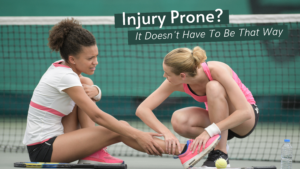
If you’re an “injury prone” athlete, then you know full well that your next injury could be career ending. For all of us, injuries spell pain, stress, doctor’s appointments and more. It’s well worth looking for ways to prevent that from happening. You may not be able to prevent all your future injuries, but there are a few simple tips that can prevent many trips, falls, and other devastating injuries. Once you’ve decided to do something about being injury prone, how do you know which injury prevention tip is really worth your time? David Starbuck Smith, a well-respected author, educator, and therapist in the field of exercise science shares a great list that would apply to all of us, seasoned athletes or not. He lists the following 7 tips in his proactive injury prevention article: 1 Restore Postural Balance 2 Vary Your Training 3 Maintain Flexibility 4 Stay Connected to your Body 5 Get Plenty of Sleep 6 Stay Hydrated 7 Meditate Start By Shrinking The List Each of these tips do have the potential to prevent injuries, but if you’re short on time, you’ll want to determine which one will give you the best bang for your buck. What you’re about to discover is that if you do the very first tip on David’s list with the right program, you will also be checking off tip number 2 thru 4 in the process. Restoring Postural Balance Many things promise to restore posture, but only one method provides the whole-body postural balance that will prevent a future injury. Devices that promise to ‘remind’ you to throw your shoulders back and sit up straight can’t produce lasting change because the right muscles aren’t being re-educated to hold your posture without you thinking about it. You’ll always be dependent on the device to remind you. Furthermore, these devices are only meant to remind you to throw your shoulders back and they aren’t able to help you correct misalignments of the feet, knees and ankles. The only program that can truly change whole-body posture is exercise based Postural Therapy. It is the only program aimed at improving your entire body’s balance head to toe, which in turn will help you prevent another injury. One Solution, Many Benefits In the decades that exercise based Posture Therapy has been around, it has helped countless athletes stay off the sidelines by improving their postural balance. Hall of Fame NFL player Brian Urlacher, credits the last 5 years of his career to Posture Therapy for keeping him in the game. You see, the better your body is stacked in gravity, the better you’ll be able to move and react to a ball or another player hurtling towards you. Athletes know their best asset to their sport is their body and how it’s trained. A well-toned physique is required to play at the top levels of any sport. The faster and more efficient your body can move and react, the better you’ll be at your sport and the fewer injuries you’ll sustain. The same principle applies to everyone else in our daily lives. Can your body react quickly enough if your toe hits a crack in the sidewalk? That’s the difference between catching yourself before you fall, and falling flat on your face. When you incorporate exercise based Posture Therapy into your daily routine, you’ll feel your posture become balanced head to toe. As a result, you’ll prevent a lot of injuries, and you’ll feel a whole lot better too. Not only does Posture Therapy provide your body with postural balance, you’ll receive new and varied exercises weekly, improve your flexibility, and you’ll be more in tune with your body than ever before. Posture Therapy Provides You With Varied Exercises Another trademark of Posture Therapy is that you’ll be prescribed a wide variety of exercises that your body doesn’t currently perform. Each new exercise you master trains your body in a new way to move or respond. As a result, your body learns new and more efficient ways to react to the world around you. Posture Therapy Improves Flexibility Improved flexibility is another benefit of posture therapy. To achieve postural balance, the length and tension of every muscle group in your body has to be balanced. The muscles must have the right amount of stretch and strength to counteract each other. Since posture improvement can’t be achieved without proper flexibility, you can be confident that every Posture Therapy routine will include whole-body flexibility, balance, and strength work. Posture Therapy Improves Your Mind-Body Connection Exercise is one of the best ways to improve your mind-body connection. Your neurons must fire to tell your body to perform an exercise. In reverse, as your body moves, your mind has to keep up with where you are in space now compared to where you were before. Maggie from the BetterUp health coaching program explains it this way: “Every time you move a muscle, sensory receptors send information to your brain about what’s happening. Doing this intentionally through exercise helps your mind become more aware of your body’s position in space, increasing your physical self-awareness.” The more self-aware you are of your body, the less trips and falls you’ll experience. It makes sense that by improving your mind-body connection, you’ll be able to prevent silly injuries. With the varied exercises provided in a posture therapy program, you’ll have plenty of new mind-body connection practice each day. Your Personal Injury Prevention Plan Does staying off the sidelines and out of the doctor’s office appeal to you? There are lots of stand-alone programs that might help with each of David’s tips, but the one program that promises the most benefit is an exercise based Posture Therapy program. Posture Therapy programs that are personalized to your pain, medical history, posture type, and activity level are available at PTXTherapy.com, and can be done on your own in the comfort of home. If you’d rather book an appointment with a Posture Therapist in your area, search for

Carolyn Vanzlow has an incredible story to tell. Her journey with pain began at the age of 7. She struggled with pain in her spine, hips, and shoulders well into her 50’s when eventually she’d just had enough. She was so limited in her activities that she had to carefully weigh how much and how she moved. She tried many modalities, but nothing really helped end her chronic pain. Finally one day she came across something completely different than everything she had already tried. With her background in medicine and varied experience of what didn’t work, she immediately knew her life was about to change forever. CAROLYN’S DISCOVERY The discovery that changed Carolyn’s life was posture therapy. Her biggest testament to its success is her pain-free active life as a competitive power-lifter. You would never know the pain she struggled with by seeing her breaking a world record at age 69. Watch her perform one of her world record breaking lifts here. Are you in the same place Carolyn was? Have you struggled with chronic pain forever? There is hope for you too. She discovered the one in a million therapy that really does provide relief from pain for everyone seeking it. She learned that she had the power within her own muscle and joint structure to overcome her pains, just by improving her posture. She got the relief she had always been seeking and can now do any activity she desires as she takes on life in her 70’s. The method and art by which Carolyn found relief is called posture therapy. WHAT IS POSTURE THERAPY? We all experience pain differently, and for different reasons from one another. Your history, favorite activities, routines, jobs, sports and more have changed your body and shaped your posture over time. In order to get out of your pains for good, just like Carolyn did, you need a good posture program or posture therapist to come alongside you and help you get your body back to straight again. A good posture therapist will find out what your exact story is and properly analyze your current posture and pains. They will systematically help you overcome each symptom and imbalance until you can claim your own pain relief success story. By re-educating your body and reminding the joints where they are supposed to be, straight and not crooked, your pain will go down and your movements will become pain-free. Carolyn didn’t stop with her own success at overcoming pain. She has devoted her life and her career to helping others discover posture therapy. She now coaches others through the same healing process that changed her life. She offers posture therapy sessions online via Zoom and also works with clients in-person at her clinic in Las Vegas. You can get started with a posture-focused therapy program from. PTXtherapy.com, or by contacting Carolyn or any of the other licensed PTX posture therapists around the world. HOPE FOR EVERYONE Many posture therapy clients have stories like Carolyn. Their testimony is the same. (Watch or read more testimonials here). You’re not broken. You can get better. The amazing thing about posture therapy is that it’s completely tailored to each individual. With this kind of personalized-to-you posture focus, there really isn’t any way you won’t get better. Whether it’s your first attempt at getting pain relief or your last, there’s hope. If you want to experience the life-changing results that Carolyn did, then it’s time to try posture therapy for yourself.
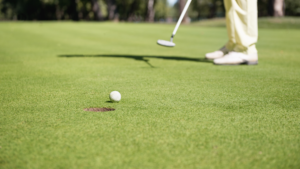
GOLF IS HARD ENOUGH, WITHOUT IT HURTING YOU TOO Is pain already a part of your golf game? According to the staff at Exercise Therapy At Kansas City, “It doesn’t have to be this way. You can overcome the pain and get back to your game – often as a better golfer because of it.” In other words, not only can you end your pain, you can improve your golf swing at the same time with the following tips. Pain is a common problem for most golfers, including professionals. GolfSupport assessed data from a study by the British Journal of Sports Medicine revealed that nearly 9 in 10 will suffer a golf-related injury at least once in a lifetime. That means that chances are, you’ve already had pain and injury slow you down, or you’re about to experience it. SOURCE OF THE PAIN The source of your pain while golfing might not be what you think it is. You might blame overuse or wear and tear, but that doesn’t explain why only one area of the body hurts and not the rest. You’d be closer to the truth if you said “repetitive motion” has caused the wear and tear in your aching knee or back. Golf is a repetitive, rotational sport. So, like it or not, planting your feet and swinging your club thousands of times every golf season places a lot of torque on the ankles, knees, hips and spine. The repetitive torque isn’t the problem either though. Fortunately for all golfers, tennis players, and others who twist and rotate all day at work or within their sport, your body was designed to move in all directions, including rotation. The problem with all of the repetitive rotation you’re hammering your body with during golf, is that you almost never rotate in the opposite direction. This places an imbalanced demand on your ankles, knees, hips, spine and shoulders. THE TRUTH ABOUT YOUR GOLF SWING It’s a proven fact that our muscles acclimate to the demands placed on them. This includes the repetition of swinging a golf club. As you lift weights or swing your club, your muscles get stronger. Sitting around on the couch and moving less results in weaker muscles. Taking this one step further, our body’s response to stimulus is detrimental when we give it stimulus in an unbalanced manner. Why does this matter to your golf swing? It matters because too much repetitive motion in one direction will inadvertently cause your body to become crooked. The hundreds of thousands of swings you’ve taken over the years adds up. You’ll need to ‘unwind’ your crooked posture if you want to reverse the effect of this stimulus you’ve put on your body year in and year out. Crooked joints hurt, and painful joints could mean the bitter end of your golf game. You can, however, reverse this negative stimulus by the same principle and begin to apply the “right” stimulus to straighten your posture. PREVENT FURTHER INJURY Even if you don’t have pain yet, straightening your posture is the first step you can take to prevent future injuries. If you’re already hurting, unwinding your crooked posture will be your fastest path to getting out of pain. The rotational forces put on the body with the golf swing result in similar changes amongst all golfers. If you’ve golfed for years, you are likely to have an elevated hip, a rotated or elevated shoulder, or one foot or knee turning out more than the other. All of these imbalances will prevent you from having a balanced stance and a natural swing. By reversing these problems, you’ll end your pain, prevent future injury, and become a better golfer. SIMPLE MOVES TO END PAIN Try this mini-golf sequence to correct the common posture problems that plague most golfers. These are also simple exercises that will improve your golf swing, whether you have pain or not. 1 Standing arm circles– This exercise gets both arms limber and working in the same way. It will level your shoulders and reduce the rotation in your shoulders and hips if you have any. 2 Standing windmill– Have one shoulder or hip that twists forward or dips lower than the other? This exercise can correct that, and it can also correct a lateral shift in your spine. 3 Upper Spinal Floor Twist– Try this exercise to open up your shoulder and give yourself an amazing back-swing. Most golfers will find that they can rotate farther back with one arm more than the other. 4 Cats and Dogs– Now that you’ve gotten your twist more even right and left, it’s time to get your hips, shoulders and spine to flex and extend in a balanced fashion. This exercise is a common one, and it’s also the best exercise to do for the rest of your life to prevent back pain. IMPROVE YOUR SWING The good news is, Travis at Exercise Therapy of Kansas City is right, you CAN play golf pain-free again. The exercises above will help you feel better, prevent further injury, and improve your golf swing — simply by straightening your posture. With better posture, you’ll have your body working for you instead of against you. You’ll have better balance and stability, more power, and the ability to rotate more fully (and with less shift or sway). The exercises in this article will get your body straighter, but keep in mind that they are still a generic sequence. If you want the fastest path to pain relief for your body, get a highly personalized program from Travis, an expert posture therapist, or try a custom-tailored virtual program from PTXTherapy.com.

Your neck hurts occasionally. Every couple of months you get this pounding headache right behind your eyes. Could your problem be text neck? According to Physiopedia, “text neck is overuse syndrome, usually resulting from excessive strain on the neck from looking down at any handheld mobile device, which can lead to headaches, neck pain, shoulder and arm pain, and breathing compromise.” Text neck looks similar to forward head posture. If you’ve been told you have either one, what can you even do about it? We’ve all seen pictures of it, and warnings about how we use our phones, but yet we continue to text all day and look down at them. I mean, is it even realistic to hold your phone at eye level whenever you use it? It’s really not, and luckily for you, there is a better solution. 20 Second Text Neck Test First things first. You only need 20 seconds to find out if you have a forward head or text neck. Find an empty wall or door, and do the following test described by Courtney at Functional Fitness, a PTX Licensed therapist: “Stand at the wall with your heels up against it. Allow your body to settle against the wall. Notice if your shoulders and head rest against the wall or if you have to push your head to get it to the wall (please don’t force your head) just notice where your head is.” My head is Forward, Now What? Once you’ve stood up for a moment at the wall, you will know whether your head is touching or not. If it’s not touching the wall easily, then chances are, your head, neck, and/or shoulder pain is stemming from your forward head or text neck posture. How To Fix “Text-Neck” Do you want to fix your text neck? You could try to lift your phone up to eye level when you use it. You might try to change your phone habits, but that probably won’t last. Fortunately there’s a much easier answer. You can correct your forward head position, and still be able to look down and use your phone all day. You see, the body just needs a little bit of ‘reverse’ stimulus to keep it in the right position. All you really need to remind the head and neck to stay upright are a few gentle exercises done up against a wall. When performed regularly, this will be enough to keep your neck from reverting back to text neck with a little phone usage. The most important thing you can do with the confirmation that you have “text neck” is to do SOMETHING. Anything. It’s worth 5 minutes of your day to reverse what’s happening to your head. If you don’t do anything, the pain will only get worse and more irreversible as time goes on. Your head and neck will continue to shift forward even more as gravity pulls it forward. Don’t let this be your story. A little prevention now will save you years of head and neck pain and medical expenses. Try this exercise from Functional Fitness to get your head back over your shoulders and fix text neck. If doing this one exercise daily isn’t enough, and it might not be depending on how bad things are, then you can get a custom-tailored program to straighten things faster at PTXTherapy.com or from the staff at Functional Fitness.

Does your back hurt when you sit too long? Most people will tell you that it must be time to find a new chair. The ergonomic chair companies would also like you to believe that the chair you have isn’t good enough so that they can sell you a new one. While it sounds like good reasoning, this actually won’t solve your problem, because it’s not the chair’s fault your back hurts. The cause of back pain and stiffness is not your chair. Here’s a few real reasons why your back hurts. REAL CAUSE OF PAIN WHEN SITTING: You Sit Too Much Everyone knows that if you sit too long without breaks, you’ll get stiff and sore. Your body is a motion machine. It wasn’t made for sitting for 8 hours behind a desk with no break. The latest research even shows that sitting is bad for you. An article published by Harvard Medical School states: “Even if you’re reasonably active, hours of sitting—whether reading a book, working on the computer, or watching TV—tighten the hip flexor and hamstring muscles and stiffen the joints themselves. Overly tight hip flexors and hamstrings affect gait and balance, making activities like walking harder and perhaps even setting you up for a fall.” 1 Your Hips Are Uneven More common than you might think, our hips can become imbalanced after an injury like a bad sprained ankle. You might have been on crutches for a week, during which time your hips learned to load unevenly. Now, 10 years later, you still walk with some of that old compensation. Uneven hips means your spine also gets crooked and will eventually hurt, especially when sitting for long periods. You Always Cross Your Legs The Same Way Old habits die hard, don’t they? We are creatures of habit, and when we cross the same leg over the top or tuck the same leg under a hip to sit for hours, we’re actually creating or strengthening uneven hips. If you didn’t read number 2 yet, the result of having uneven hips is pain. You’ve Lost Your Low Back Arch This may be the most common reason that we see low back and hip pain. You were born with 2 gorgeous spinal curves for a reason. That’s how your body absorbs the force of gravity while you sit, stand, and move. If those arches flatten, the disks between your vertebrae will become susceptible to bulging or herniating. The longer you sit in C shape, the faster you will lose your proper S curves. The result? You guessed it. Pain. So, now that you know that your problem isn’t your chair, you’re probably wondering how to fix your uneven hips or flattened spinal arches? The answer is simple. You need to move, and you need to get the right movements into your day. A BETTER SOLUTION THAN A NEW CHAIR This Mini Routine by Zeena at VerticAlign will jumpstart your healing. She’s a PTX Licensed therapist, and she’s got you covered. With her four minute routine, you’ll start to break up your sitting patterns and heal your body. She sums it up well: “You can search for hours and hours on the internet to try to find an easy way to get proper posture exercises at your desk, or you could follow this mini plan and know that you’re getting the best possible 4 minute routine that’s worth your time.“ Do you really want another crappy chair that leaves you hurting? Changing full body posture is the best and most effective ergonomic fix there is. Start with the exercises from VerticalAlign. When you’re ready for more, reach out and get a fully customized program from Zeena at VerticAlign, or try the personalized on-demand therapy programs at PTXtherapy.com. New chair or not, take care of your body, you need it to last. 1 https://www.health.harvard.edu/pain/the-dangers-of-sitting
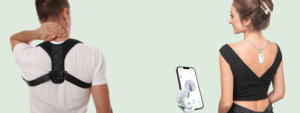
They are everywhere, aren’t they? If you search online for posture correction devices, you’ll find plenty to choose from. You might even come across glowing reviews of these devices. Can you trust reviews? Well, we all know that reviews can be suspect. But, they are attempting to help people look and feel better by buying the device. It’s a good goal, but here’s the truth: GOOD POSTURE IS PRACTICALLY UNACHIEVABLE WITH A DEVICE. Posture devices might prop you up or nag you into a better posture for a moment. But, let’s understand why they aren’t going to solve your posture problem. Once you understand posture, you’ll probably realize these devices will make you worse. First, What Is Good Posture? You need your muscles on board to have good posture. Here’s what good posture looks like: Head centered over shoulders Shoulders level and square Spine maintains “S” curve Ankles, knees, hips and shoulders stacked vertically Good posture is not just sitting up straight or holding your shoulders back. Good posture is achieved when your joints are aligned head-to-toe. Everything works better when the joints are aligned. Your bones and muscles move better. Circulation and digestion is better. Breathing is better. You look better and feel better about yourself. Good posture is worth the effort. Poor posture, on the other hand, hurts. One stark example is forward head position. When your head is forward, gravity increases the relative weight of your head the further forward it is positioned (Figure 1). Your small neck muscles are not meant to hold up your head, but instead are designed to turn it left or right, up or down or rotate it in a circle. These muscles can become so painful and dysfunctional that you are no longer able to turn your head or look up. Your head position isn’t the only thing you should be concerned about. Joints that aren’t stacked properly have to work harder against gravity to keep you from toppling over. This causes uneven wear on the cartilage in your joints. Your ligaments and tendons will snap or get strained under the increased stress. Your muscles will ache, and may even tear if the stress becomes too much. The only way around this deterioration is to get your muscles to hold your body in good posture. History Of Posture Correction The first posture correction device was the corset. It became popular in sixteenth century Europe. It was used for centuries to “beautify” women. Sitting up straight in a corset made the wearer appear to be a prim and proper lady. Only women from the lower classes of society would dare be caught slouching. Corsets also caused physical limitations for women during this time. A corset made movement difficult, so women who wore them were unlikely to engage in sports or physical labor. It’s no surprise the corsets of the past have lost their appeal. Their restrictive nature would prevent the modern woman from acting on the many freedoms they’ve gained since then. If corsets are out, but slouching is bad, what else is there? There are still many valid reasons to improve your posture. The most important one is that doing so improves your health. Good posture helps the systems of your body work better. The diaphragm and lungs have more room to expand. Blood travels more freely through the arteries, vessels, and capillaries. Food digests more easily and waste is eliminated more efficiently. Best of all, you’ll feel better and have less pain. Let’s explore some of the options you have for improving your posture, and find out what works and what doesn’t. Posture Braces You may be prescribed a posture correction device from someone you trust. Doctors and physical therapists may recommend posture braces to help with back pain. They come in a variety of shapes and sizes, and are adjustable. Many fit around the shoulders and apply tension across the upper back and shoulder blades. Some wrap around your back with stiff support mechanisms. State Of The Art Posture Devices A different group type of modern posture devices promise to “nag” you into good posture. These devices attach directly to the skin with adhesive or are worn around your neck. They vibrate when you slouch to nag you back into sitting up. These may actually work to get you to shift in your seat temporarily. Unfortunately, this doesn’t improve your posture. The Truth About Posture Correction Devices Posture correction braces and devices can’t give you good posture, despite what they may claim. No part of your body works in isolation. If you are nagged to sit-up, you might shift your upper back and shoulders. What you will fail to do is shift your pelvis forward and place the proper arch in your low back. No device can align your joints properly from head to toe. Good posture is not just sitting up when you’re at your desk. Good posture comes from good muscle function. Sitting and standing straight, walking, running and jumping are all guided by your muscles. Danger Of Braces Posture braces are even worse for you than the nagging posture devices. At least with the devices you won’t lose muscle function. Think about it. A full body cast could perfectly align your joints, but you would atrophy to the point of never being able to move again if you stayed in it too long. External posture correctors, in the form of a brace, are attempting to replace the function of your muscles. There will come a day where you’ll become dependent on the brace entirely because the muscles aren’t needed. Your muscles have a very important job. They are responsible for movement and joint positioning. They hold your body in proper alignment. When you use a posture correction brace to do it for you, the muscles can slack off. Your posture muscles won’t have to do as much work to hold you up. When the muscles stop working, they get even weaker. You’ll become
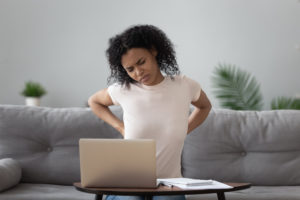
Fixing Your Back Pain We all know back pain is no fun. You or a loved one are probably struggling with back pain right now. You might be thinking there is no way you could feel better in 5 minutes, but you can! I’m not talking about taking something from your medicine cabinet, or getting into a state of relaxation where you imagine your back doesn’t hurt. I’m talking about real help using the floor, a chair, gravity, and 5 minutes of rest. You are about to learn the real reason for your back pain, and why spending 5 minutes doing one simple thing is well worth your time. Understanding Your Back Pain First, understand your pain. When your back hurts, your nerves are telling you something is wrong. But what? You must first understand why it hurts. Yes, your doctor may have given you a diagnosis for herniated or bulging disks, degenerative disk disease, stenosis, spondylothesis, sciatica, or SI joint dysfunction. It might initially comfort you to get a diagnosis, but a diagnosis isn’t an answer. It won’t tell you what’s wrong or how to fix it. The difficulty with back pain is that it’s not the same for everyone. Back Pain is very personal. Your back might hurt for a very different reason than your Aunt’s or your neighbor’s. For example, Aunt Jane might have knock-knees. Your neighbor might have uneven hips. You might have ‘winging’ shoulder blades or a flat lower spine. You all might experience a similar kind of pain, but it’s there for different reasons. Or is it? In Postural Therapy, we know that one thing fixes each of these issues. Specifically, this means your aunt, your neighbor, and you just need to straighten your joints and spinal alignment. Here’s an even more comprehensive list of all the potential posture problems that could be contributing to your back pain: Forward head position Rounded shoulders (slouching) Uneven shoulders (one side higher than the other) Twisted hips Uneven hips (one side higher than the other) Leaning to one side Swayback Exaggerated “S” curve of the spine Flattened Spine Knock-Knees (valgus stress) Bow-legs (varus stress) External Femurs (knee caps pointing outward) Internal Femurs (knee caps pointing towards each other) Tibial Torsion (kneecap pointing different direction than the feet) Wide Stance Flat feet Everted Feet (feet pointing outward) Second, address your posture. To fix your back pain you must fix your crooked posture. People suffering from back pain might have a different combination of the above imbalances, but the fix is simply to straighten up from head to toe [No, standing up straight is not the answer] Usually, we get fixated on the pain itself. The typical treatments of heat, ice, braces, or medications will not fix your crooked posture or your pain. Your posture problem is causing the inflammation, pinched nerves, or muscle spasms; so your posture is what needs a fix. Likewise, you can sign up for a surgery to fuse the spine or remove part of a disk (laminectomy) with the fading hope that it will end your nerve pain. Fusing a joint or cutting out portions of your disks doesn’t fix crooked posture. No matter your back pain diagnosis, it’s of utmost importance that you straighten out your crooked body to rid yourself of the pain. Static Back: Your 5 Minute Fix Description: Lie on your back with legs up and over a block, chair, or couch with knees bent at 90 degrees Relax your arms straight out from the shoulders, or just below, with palms up Relax your legs and shoulders, letting them settle into the floor and chair /block Breathe deeply and feel your body, especially your lower back, settle into the floor Lay in this position for 5 minutes or longer (If your head is unable to settle onto the floor, it’s ok to use a small pillow at first. It’s also important to note that this is a sign that you have a very forward head position. Over time gravity will improve your forward head position, so progress with less propping up of your head as you are able to each day.) The Science Behind Static Back The static back exercise is simple but quite powerful. It works by the PTX principle called ‘box logic’. The exercise uses the floor and gravity to straighten your joints. When you lay down on the floor, your shoulders, head, and upper back are able to settle into a level position. Gravity is your friend, as it gently pushes each joint evenly down onto the floor. Placing your legs over a chair puts your hips and knees into a 90 degree angle. This position forces your hips and lower body to level out. The entire body is affected by this simple exercise. You can look at this quick video to learn more about box logic: Posture Therapy is the cutting-edge answer for all musculoskeletal pain. Box logic can get you out of back, hip, knee, shoulder, wrist, or foot pain. When you stack the joints and get the muscles balanced again, your body has no choice but to straighten up, whether you try to stand up straight or not. When your joints are straight, your pain exits. There won’t be anything for your nerves to complain about, and you can get back to living. Your whole-body-fix is waiting. Learn more @ PTXTherapy.com Your Posture Is Your Pain
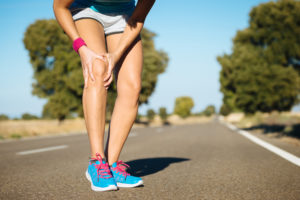
No, the straps don’t work, period. But, there is a solution just ahead. If you are an avid runner, you’ve either noticed your comrades wearing knee (patellar tendon) straps, or you wear one or two yourself. If so, you’ve bought into the lie that these particular braces are effective at reducing or removing knee pain. Or, maybe you just don’t know what else to do. Fortunately, we have a permanent solution. First, why don’t these knee straps work? These knee straps are designed to put pressure on the patellar tendon and support the kneecap, supposedly to improve the way your kneecap tracks. Doctors often recommend using a knee band strap if you have Osgood Schlatters, Patellar Tendonitis (Jumper’s Knee), Chondromalacia Patella or Runners Knee. An external strap simply cannot change the way your knee tracks. WHY DOESN’ T IT WORK? Putting pressure on a tendon doesn’t change the way your knee tracks. Your knee tracks the way it does because of the tug-of-war going on between the muscles around the knee. Here’s a simple example. If your inner and outer thigh muscles are out of balance, the knee will get pulled into a knock-knee position or outwards to a bow legged position. Once the knee is pulled out of alignment, the kneecap will have a crooked track. How exactly is putting a pressure band on that crooked knee going to help? It can’t. No longer does your knee move in a stable hinging motion, and no longer will your kneecap have a straight groove to track in. The knee strap can’t fix the muscles, so it can’t fix the problem. So, if not knee straps, then what can you do? Let’s think back to the tension problem that caused the knock knee position in the example above. In order to get the knee tracking properly again, you’ll need to straighten out the ankle, knee, and hip joints. Wait, now we have to consider the joints above and below the knee? Well yes, since the muscles surrounding the knee are attached up to the bones of the hips, or down to the bones of the ankle. Pain in a joint means there is something out of place elsewhere which is generating the pressure or misalignment. Focusing on one joint at a time is never going to work because the joint pain is just a symptom. WHOLE BODY FIX Once you understand the whole body connection, you’ll know that a whole body fix is the only real solution for knee pain, or any muscle and joint pain. Your knee might be the joint that hurts, but it’s likely a problem with your hips and ankles. Can you bend over and touch your toes? Can you move your ankle freely in all directions? Over time, with misuse, or lack-of-use, a lot of these movements are lost. These are all things that can cause a joint to get out of position. Returning the muscles around the knee to their proper tension and strength will get your knee to track properly. You’ll need to wake up the weak muscles to allow the overworked muscles to relax. When you gently retrain your muscles to do their proper jobs, from head to toe, your joints will return to their proper place, and your pain will be permanently gone. The fastest way to get there is with PTX. We’ve studied posture and the way the body moves for decades. We know exactly which exercises and in exactly which order will make your joints straight again. If you want your pain to leave and your running to improve, we’ve got you covered. PTX Therapy has put together an easy to follow digital program. You’ll know exactly what to do to return your body to it’s best pain-free alignment. SUMMARY Now it’s up to you. You can try all the knee straps and other external gimmicks available, or you can fix your muscles to fix your joints. If the strap isn’t addressing the real problem, then you think of it as bling to impress your friends. Of course, a better time without the pain is much more impressive to everyone. Check it out today: www.ptxtherapy.com

Wow, there is so much to blame moms for; emotional enmeshment issues, overweight (clean plate club) issues, and husbands and wives fighting about family vacations, to name a few. But, most moms instinctively tried to do one thing right for your back, and hips, and knees, and neck. She said, SIT UP STRAIGHT! Yep, great advice, if you could pull it off. Of course, it isn’t just sitting up straight, it’s standing up straight as well. The secret to your back pain problem is POSTURE. Most doctors and physical therapist don’t really understand the Power of Posture because they are caught in the old adage that, “If the only tool you have is a hammer, you’ll treat every problem as a nail.” You don’t go to lawyers for marriage counseling. You don’t go to surgeons for non-invasive natural solutions. And, oddly enough, you don’t want to go to most physical therapists for long-term physical pain solutions. Lawyers go to divorce court, surgeons cut, and physical therapists work on one part of the body at a time. The truth is that you need the right strategy that fits the right goal. What Causes Pain? This is tricky because the word ‘causes’ is misleading most of the time. If you were asked, “What causes rain?” what would you say? Is it moisture in the air? Is it a front where cold air and warm air collide? Moisture can be fog and a cold front can be totally rain free. The key is that it is a combination, a system, that causes the rain. With pain, it’s quite similar. Of course, your nerves convey signals to your brain that say you hurt. So, no nerves, no pain. But also, it could be no brain no pain! The real key to your nerve pain is either that there is something wrong with the nerve all by itself, or the nerve is experiencing pressure from somewhere. That’s why posture is so important. You body is a system, so even pain is caused by some combination of elements or factors. If we think about it in simple terms, how could your muscles or joints really hurt if everything is lined up correctly (like when you were a child)? Frankly, your musculoskeletal system is fine when everything is in the right place. We can just as easily say that ‘being crooked’ is the source of your hurt. Over the years your body has gotten crooked because of your environment, injuries, and lifestyle; and that crookedness makes you hurt. Essentially that’s the problem. However, the problem is a little more involved than that. It’s not that your back hurts because it’s crooked (maybe), but it could have a lot to do with your neck, or your foot, or your hip. Since it’s a system, the solution has to consider everything. When a massage therapist rubs you or a chiropractor cracks you, you do get a little temporary relief. But in no time at all, aren’t you back to hurting? Yes, sit up straight if you can. But you can’t because you have a spasm-vs-weak muscle problem. If one muscle is stronger or busier than its partner muscle, then you are just going to be crooked. Think of tug-of-war where all the big guys are on one side and the puny guys are on the other. The answer is not trying to straighten up, the answer is getting your deep postural muscles back into shape, back into balance. At PTX Therapy we bring the solution home. Our patented technology allows you to follow a specific, gentle, unique-to-your-body exercise routine that gets the muscles back to balance and strength. Naturally, when your muscles are fine, your bones and joints will straighten up so inflammation and wear-and-tear can be stopped in their tracks. If you want to try the PTX Magic for 14 days free, we’ve got you covered. Just click below and learn how you can become posture-right and pain-free. Plus, your mother will be so proud of you. Get PTX Therapy
Millions of us wake up each day with muscle, joint...
Read MoreIf you’re an “injury prone” athlete, then you know full...
Read MoreCarolyn Vanzlow has an incredible story to tell. Her journey...
Read MoreGOLF IS HARD ENOUGH, WITHOUT IT HURTING YOU TOO Is...
Read MoreYour neck hurts occasionally. Every couple of months you get...
Read MoreDoes your back hurt when you sit too long? Most...
Read MoreThey are everywhere, aren’t they? If you search online for...
Read MoreFixing Your Back Pain We all know back pain is...
Read MoreNo, the straps don’t work, period. But, there is a...
Read MoreWow, there is so much to blame moms for; emotional...
Read More“Prior to participating in postural therapy, users responded that they...
Read More“Users also reported a positive impact on their work and...
Read More“The overall factor-of-two superiority of PTX over Control Group was...
Read More“Symptoms evaluated: Headaches, Neck, Shoulder, Elbow, Wrist & Hand, Upper...
Read More“The PTX group experienced highly significant improvements (reductions) in their...
Read MoreEMPLOYEE PAIN RELIEF REPORT Reported from several large case studies,...
Read More“Evaluations show an overwhelming dominance of favorable replies regarding improved...
Read More“Evaluations show an overwhelming dominance of favorable replies regarding improved...
Read More“PTX was demonstrated to be superior to that of the...
Read More© 2025 PTX Therapy, LLC. All Rights Reserved. Terms of Use Privacy Policy
